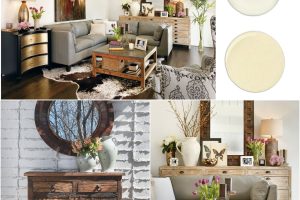Nature’s Influence: Incorporating Rustic Elements into Your Home Decor

Introduction to Nature’s Influence in Home Decor
As the world becomes increasingly urbanized, many homeowners are turning to nature-inspired designs to create a sense of tranquility and connection within their living spaces. Rustic elements in home decor evoke a charming, earthy appeal that can bring warmth and character to any home. Let’s dive into some of the benefits of incorporating these rustic elements and explore popular decor trends that capture the essence of nature.
- Nature’s Influence: Incorporating Rustic Elements into Your Home Decor
- Introduction to Nature's Influence in Home Decor
- Benefits of Incorporating Rustic Elements
- Popular Rustic Decor Trends
- Bringing the Outdoors In: Natural Materials to Use
- Wood as a Key Element
- Stone and Clay Accents
- Earthy Color Palettes for a Cozy Ambiance
- Neutral Tones and Earthy Hues
- How to Use Greenery Effectively
- Embracing Imperfections: Wabi-Sabi Aesthetics
- Understanding the Beauty of Imperfection
- Incorporating Handmade and Vintage Pieces
- Creating a Relaxing Retreat with Rustic Textures
- Using Natural Fabrics Like Linen and Wool
- Adding Texture with Woven Baskets and Rugs
Benefits of Incorporating Rustic Elements
Incorporating rustic elements into home decor can significantly enhance both aesthetics and atmosphere. Here are some key benefits:
- Warmth and Comfort: Rustic designs often feature natural materials like wood and stone, which envelop spaces in a welcoming warmth. For example, installing reclaimed wood beams in a ceiling instantly makes a room feel cozier.
- Timeless Appeal: Rustic decor has a classic charm that never goes out of style. Many homeowners appreciate the ability of rustic elements to transcend trends, ensuring their spaces remain relevant for years to come.
- Connection to Nature: With a growing emphasis on sustainability, rustic decor often embraces eco-friendly materials. By incorporating these elements, individuals create a direct link to nature, nurturing mental well-being and promoting a sense of peace.
Popular Rustic Decor Trends
As home decor evolves, several rustic trends have captured the hearts of many. Some of these include:
- Farmhouse Chic: This trend often combines contemporary elements with traditional farmhouse fixtures, such as shiplap walls, vintage lighting, and distressed furniture.
- Modern Cabin: Infusing a modern twist into cabin aesthetics, this trend emphasizes large, open spaces, floor-to-ceiling windows, and neutral color palettes paired with natural wood and stone accents.
- Industrial Rustic: By blending vintage industrial features with warm wooden tones, this trend plays with contrasts—think metal furniture complemented by reclaimed wood shelves.
- Bohemian Rustic: Mixing boho patterns and vibrant textiles with rustic essentials results in a curated yet relaxed vibe. Layering rugs and adding plants are integral to this eclectic style.
These trends not only beautify spaces but also transform homes into calming retreats filled with personality. As you explore the various rustic elements, you may find that your home becomes a true reflection of your unique style, rooted in nature’s enduring influence.
Bringing the Outdoors In: Natural Materials to Use
Continuing our exploration of nature’s influence in home decor, it’s essential to consider the materials that help bring the outdoors into our living spaces. Embracing natural materials not only enhances the aesthetic appeal but also fosters a connection to the environment. The most prominent materials to consider include wood and stone, alongside their charming counterparts, clay accents.
Wood as a Key Element
Wood is undeniably a cornerstone of rustic decor. Its timeless quality and versatility allow it to be integrated into nearly every type of design. Here are some favorite ways to incorporate wood:
- Flooring: Wide-plank hardwood floors exude warmth and a sense of history. They can serve as the perfect canvas for your rustic home, grounding the space while allowing other elements to shine.
- Furniture: Handcrafted wooden furniture, such as a reclaimed coffee table or a sturdy dining table, evokes character. Each piece tells its own story, sometimes featuring knots and variations that add charm.
- Accent Walls: A wood accent wall, using reclaimed barn wood or shiplap, can transform an ordinary room. It creates a focal point that sparks conversation and invites guests to linger.
But beyond aesthetics, wood also enhances indoor air quality, helping to create a healthier home environment.
Stone and Clay Accents
Adding stone and clay accents further enriches the rustic theme. The tactile quality and coolness of these materials can balance the warmth of wood:
- Stone Features: Consider using natural stone for a fireplace surround or as a statement wall in a living area. Not only does stone bring in a rugged aspect, but it also connects the indoors with the natural landscape.
- Clay Pottery: Beautiful clay pottery—ranging from vases to decorative bowls—adds an artisanal touch. They can be filled with seasonal blooms or used as standalone pieces to infuse warmth and authenticity.
- Tiles: Natural stone tiles in kitchens or bathrooms lend a rustic feel while being practical and durable. Pairing them with wooden accents creates a harmonious blend.
Embracing wood, stone, and clay blurs the lines between indoors and outdoors, inviting nature to play a starring role in your home’s decor. As you thoughtfully incorporate these natural materials, you’ll likely notice how they create a serene ambiance that nurtures well-being and comfort.
Earthy Color Palettes for a Cozy Ambiance
As we move deeper into the realm of nature-inspired decor, it’s essential to consider how color plays a vital role in creating a cozy and inviting atmosphere. Earthy color palettes not only provide a warm backdrop but also serve to reflect the organic beauty of the world outside. Let’s explore the appeal of neutral tones and earthy hues, followed by effective ways to integrate greenery into your scheme.
Neutral Tones and Earthy Hues
Neutral tones and earthy hues are the perfect choice for establishing a serene ambiance. These colors often evoke the feeling of being in nature, promoting relaxation and comfort. Here are some options to consider:
- Warm Whites and Beiges: Soft whites and creamy beiges create a soothing canvas that can make any space feel larger and more open. They work well with various textures, enhancing the overall feel of warmth.
- Earthy Greens: Subtle shades like sage or olive green can bring a touch of the outdoors inside. These colors pair beautifully with wood, complementing the natural elements throughout your home.
- Rustic Browns and Terracotta: Rich browns mimic the bark of trees, while terracotta tones remind us of sunbaked clay. Using them as accent colors through furniture or decorative pieces can amplify the earthy feeling.
- Blues and Grays: Soft blues and grays echo the skies and waters found in nature. They can provide a cool contrast to the warm hues, creating a balanced and inviting space.
How to Use Greenery Effectively
Incorporating greenery into your home decor goes hand in hand with earthy color palettes, enhancing the connection to nature. Here’s how to do it effectively:
- Strategic Placement: Consider placing plants in key areas like window sills, corners, or even hanging from the ceiling. This draws the eye and ensures that greenery becomes a focal point.
- Mixing Sizes and Varieties: Use a mix of plant sizes—from small succulents to large potted fiddle leaf figs—and aim for different textures. This variety adds depth and interest.
- Plant Choices: Opt for low-maintenance plants, such as snake plants or pothos, which thrive indoors and contribute to improved air quality. Not only do they look great, but they also bring life to your space.
- Using Planters: Choose planters that echo your earthy palette—think terracotta pots, woven baskets, or rustic wooden containers. These finish the look while harmonizing the room.
By embracing neutral tones, earthy hues, and lush greenery, you cultivate a space that not only feels cozy but also deeply connected to the natural world. As you navigate through your decor choices, remember that colors and plants work harmoniously to promote peace and comfort in your home.
Embracing Imperfections: Wabi-Sabi Aesthetics
As we delve further into the art of decorating with nature in mind, it’s important to embrace the concept of wabi-sabi. This Japanese philosophy celebrates the beauty of imperfection and transience, offering a refreshing perspective on home decor. Rather than striving for perfection, it encourages us to find joy in the unique character and history found in our spaces. Let’s explore the essence of wabi-sabi and how to incorporate handmade and vintage pieces into your decor.
Understanding the Beauty of Imperfection
Wabi-sabi teaches us that true beauty lies in the flaws and irregularities of an object. This philosophy invites us to appreciate the following:
- Authenticity: Each imperfection tells a story. A small crack in a cherished vase or the irregular surface of a handmade bowl adds depth and character, reminding us of the object’s journey.
- Aging Gracefully: Just as nature evolves, so do our possessions. Embracing signs of wear—like patina on metal or faded fabric—can create a sense of warmth and nostalgia.
- Mindfulness: Applying wabi-sabi principles encourages you to slow down and appreciate the present moment. Choosing decor with imperfections reinforces this mindful approach, creating a calming effect in your space.
Incorporating this philosophy into your home can transform it into a sanctuary that reflects your authentic self.
Incorporating Handmade and Vintage Pieces
Now that we understand the allure of imperfection, let’s focus on how to integrate handmade and vintage pieces into your decor effectively:
- Handcrafted Items: Look for pottery, textiles, or furniture created by local artisans. These pieces often showcase unique characteristics and imperfections. For example, a hand-thrown ceramic mug may have an uneven rim, but it adds charm to your morning routine.
- Vintage Finds: Hunting for vintage treasures at flea markets or thrift stores is not only thrilling but also fruitful. Pieces like an antique side table or a distressed mirror can serve as focal points while introducing character.
- Layering Textures: Mix various materials—wood, metal, and textiles—to create a rich, layered aesthetic. For instance, place a vintage wooden tray on a handmade fabric tablecloth to add depth to your dining space.
- Personal Touch: Incorporate items that hold personal significance. A family heirloom or a piece of art from a cherished trip can anchor the room in memories while showcasing its imperfections.
By embracing accessories that embody the wabi-sabi spirit, you deepen your connection to your home while allowing its true character to shine. It transforms your living space into a beautiful representation of life’s organic journey, where imperfections become your home’s most captivating stories.
Creating a Relaxing Retreat with Rustic Textures
As we continue our journey into nature-inspired decor, creating a relaxing retreat is all about enhancing comfort through the careful selection of textures. A well-designed space should not only be visually appealing but also invite you to sit back and unwind. Rustic textures, in particular, can elevate a room’s ambiance and bring a cozy, lived-in feel. Let’s explore how to use natural fabrics like linen and wool, as well as incorporate woven baskets and rugs into your decor.
Using Natural Fabrics Like Linen and Wool
Natural fabrics are essential elements in achieving a rustic retreat. They offer warmth, comfort, and a touch of organic beauty. Here’s how to effectively incorporate them:
- Linen Drapery: Opt for linen curtains that filter light softly. The relaxed folds of linen can create a serene atmosphere, enhancing the room’s natural light and allowing gentle breezes to flow through. Imagine sipping tea while the sunlight dances through lightly textured drapes, creating an ever-changing play of shadows.
- Wool Throws: A cozy, knitted wool throw draped over a chair or bed adds warmth both visually and physically. Whether it’s a chunky knit or a delicate weave, wool throws invite you to curl up and enjoy a good book on chilly evenings.
- Accent Pillows: Use a mix of linen and wool in your cushions. By selecting pillows in different textures and colors, you can create an inviting seating area that beckons you to relax.
Adding Texture with Woven Baskets and Rugs
Incorporating woven baskets and rugs can also enrich the textural elements of your retreat, providing layers of detail that enhance the rustic charm. Here are some suggestions:
- Woven Baskets: Use baskets for storage and decor alike. They are perfect for organizing throws, magazines, or even toys, all while adding a natural, earthy touch. Consider using a large wicker basket next to a sofa filled with cozy blankets, making them readily accessible.
- Layered Rugs: A beautiful area rug can ground a space and add warmth. Layering a soft, natural fiber rug—such as jute or sisal—with a plush, patterned rug creates depth and interest. For example, a jute base paired with a colorful Persian rug can define conversation areas and add an extra layer of comfort.
- Wall Art: Don’t forget about texture in wall decor! A wall hanging made from natural fibers or a macrame piece can draw the eye and complement the rustic feel of your retreat.
By thoughtfully incorporating these natural fabrics and textured elements, you create a relaxing retreat that wraps you in warmth and comfort. Your space becomes a haven that reflects the beauty of nature and invites tranquility, allowing you to unwind and rejuvenate.





